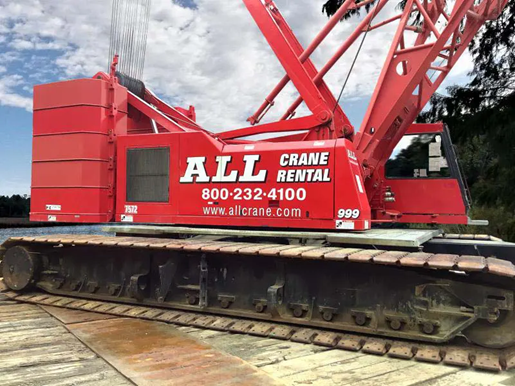
In the world of heavy-lift equipment, capacities have grown exponentially over the past decade. With some lattice boom crawler cranes handling well over 1,000 tons, one that tops out at 275 tons might seem almost quaint. But it’s a crawler weight class that’s been the contractor’s choice, finding homes in infrastructure, refinery and plant work, and commercial construction markets.
ALL Crane Rental of Alabama, a member of the ALL Family of Companies, is keeping two such cranes busy with long-term railroad bridge renovation jobs. In both cases, a Manitowoc 999 was specified to perform heavy lifting for a ground-up renovation of bridges over rural rivers, one in Alabama, the other in Georgia.
Scott Swearengin, sales representative from ALL Crane Rental of Alabama, says its uncanny how alike both projects are, from topography, remoteness of location, and bridge type. ALL’s customer for both jobs is Hall Contracting of Louisville, Ky.
The bridge location, in Theodore, Ala., is so remote and so heavily wooded, Hall had to build a temporary road so trucks could access it.
“We specified the Manitowoc 999 because it gave us the appropriate lift capacity and had the reach we needed,” said Swearengin. “We set up the crane in the middle of the Fowl River below the bridge, and with 210 feet of main boom, the Triple 9 is able to reach both ends of the bridge, left and right, from that position.”
The crane was at the site for a total of six months, first doing foundation work then replacing beams and railroad trusses. Weights to be lifted range from tub girders at 40,000 pounds all the way up to bridge spans topping out at 122,000 pounds. The Triple 9 handled these and everything in between.
Setting up a crawler in an active river required three layers of matting to keep the tracks above water level. The crane also had to make frequent crawls to the riverbank when rains threatened to raise the water level. Due to railroad schedules, work was off-and-on, typically consisting of several days on followed by several days off.
Work in Alabama was completed mid-September with mirror-image job in Georgia wrapping up soon.
End of an era?
There’s nothing unusual about two Triple 9s keeping busy; that’s been the norm for two decades. However, now a replacement model is looming.
About a year ago (Sept. 2022), Manitowoc announced plans to phase out the Triple 9, replacing it with the new MLC250 – basically a Triple 9 with some added features from the MLC line. But after more than 20 years as the premier machine in its class, there are still plenty of Triple 9s out in the field performing meaningful work.
Manitowoc introduced the 999 in June 2000 at a press event in Paris. At the time, it was slotted between the 230-ton model 888 and 300-ton model 2250. It grew to become a highly sought-after piece of equipment across multiple applications.
Rick Mikut, ALL Crane’s crawler crane division manager, says the unit is prized for its versatility. “It has a smaller footprint, similar to the next weight class down,” said Mikut. “But at the same time, it gives you additional capacity within that smaller space.”
Mikut isn’t surprised that ALL Crane Rental of Alabama is keeping its Triple 9s busy with bridge work. “Bridges are projects for which this unit has always excelled. There are typically strict load limits in bridge work. The higher capacity of the Triple 9 delivers the power these projects need while staying well within the limit.”
Even with the MLC250 on the horizon, and with ALL scheduled to take delivery of several of the new units next year, Mikut believes the Manitowoc 999 will remain in the field for years to come. “The Triple 9 has been one of our hottest cranes in the past 18 months. I can’t keep them in the yard. As soon as one comes back from rent, it goes right back out again. We keep them well maintained, so they will have a useful service life for the foreseeable future.”
With the MLC250 being basically built on a 999 frame, replacement parts should remain easy to come by, making proper maintenance of existing 999s possible.
The crane business is always evolving. Phasing out the 999 to make way for the MLC250 is another sign of the times. “The electronics of heavy lift equipment are always improving and getting more sophisticated,” said Mikut. “They help increase precision, help improve performance, and help make the equipment even safer to operate. And each upgrade has also brought a higher level of interchangeability.”
Now, rather than each crane model having its own specific electronics and interface, it’s not unusual for every model across a series to have many of the same components.
“The MLC250 will have the newer electronics of the other cranes in the MLC line and an updated cab, but the same boom and the same footprint as the Triple 9,” said Mikut. “It’s been a great crane, and its legacy will continue in the MC250.”

